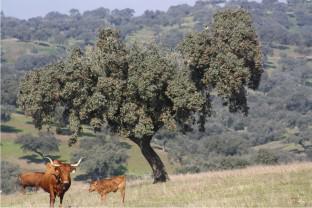Agronomy for Sustainable Development ( IF 6.4 ) Pub Date : 2023-03-31 , DOI: 10.1007/s13593-023-00883-y Corentin Pinsard , Tiago G. Morais , Tiago Domingos , Francesco Accatino , Ricardo F. M. Teixeira

|
The Alentejo region in Portugal is vital to the country’s beef industry and is home to 60% of the Portuguese beef cattle population. Farmers increasingly rely on imported synthetic fertilizer and feed. The uncertainty of global oil supply and indirect inputs calls into question the robustness of the beef farming system in Alentejo, defined as the capacity of the system to maintain its function (beef production) in spite of a disturbance (decreased input availability). An additional challenge is the need for reducing greenhouse gas emissions to meet decarbonization goals. At present, these challenges are being addressed through management practices such as expanding areas of high-yield sown biodiverse pastures and fattening steers partially on grass rather than concentrates. These practices have been shown to reduce greenhouse gas emissions, but their effect on the robustness of beef production when inputs are scarce is unknown. To fill this gap, we adapted a dynamic nitrogen mass flow model to assess herd dynamics and calculate a greenhouse gas emissions balance. We applied the model for seven scenarios corresponding to different combinations of management practices over 50 years with increasing input constraints. We estimated, without changes and without constraints, a greenhouse gas balance of 55 kgCO2-e kg carcass−1 year−1 (100-years global warming potential). Without changes but faced with constraints, meat production dropped 60% (low long-term robustness) in 50 years while increasing by 17% the greenhouse gas balance. Our results showed that a combination of high-yield legume-rich pastures, maximization of grass intake, herd size reduction, and increased animal productivity allowed the smallest reduction of meat production (28%) and largest greenhouse gas emission reduction (30%, i.e., 38.9 kgCO2-e kg carcass−1 year−1). This was the best, among the combination studied, at mitigating the trade-off between robust meat production and climate change mitigation.
中文翻译:

葡萄牙阿连特茹进口投入限制下未来强劲肉类生产和气候变化缓解战略
葡萄牙的阿连特茹地区对该国的牛肉产业至关重要,拥有 60% 的葡萄牙肉牛。农民越来越依赖进口合成肥料和饲料。全球石油供应和间接投入的不确定性使人们质疑阿连特茹牛肉养殖系统的稳健性,该系统被定义为尽管受到干扰(输入可用性降低),该系统仍能维持其功能(牛肉生产)的能力。另一个挑战是需要减少温室气体排放以实现脱碳目标。目前,这些挑战正在通过管理实践来解决,例如扩大高产播种生物多样性牧场的面积,以及部分在草上而不是集中在草上的育肥牛。这些做法已被证明可以减少温室气体排放,但当投入稀缺时,它们对牛肉生产稳健性的影响尚不清楚。为了填补这一空白,我们采用动态氮质量流量模型来评估畜群动态并计算温室气体排放平衡。我们将该模型应用于 7 种情景,这些情景对应 50 多年来不同的管理实践组合,并增加了输入限制。我们估计,在没有变化和没有限制的情况下,温室气体平衡为 55 kgCO2 -e kg carcass −1 year −1(100 年全球变暖潜势)。在没有改变但面临限制的情况下,肉类产量在 50 年内下降了 60%(低长期稳健性),同时温室气体平衡增加了 17%。我们的结果表明,高产富含豆科植物的牧场、草摄入量最大化、畜群规模减少和动物生产力提高的组合使得肉类产量减少最小(28%)和温室气体排放减少最大(30%,即, 38.9 kgCO 2 -e kg 胴体-1年-1 )。在所研究的组合中,这是在缓解强劲的肉类生产和缓解气候变化之间的权衡方面最好的。











































 京公网安备 11010802027423号
京公网安备 11010802027423号